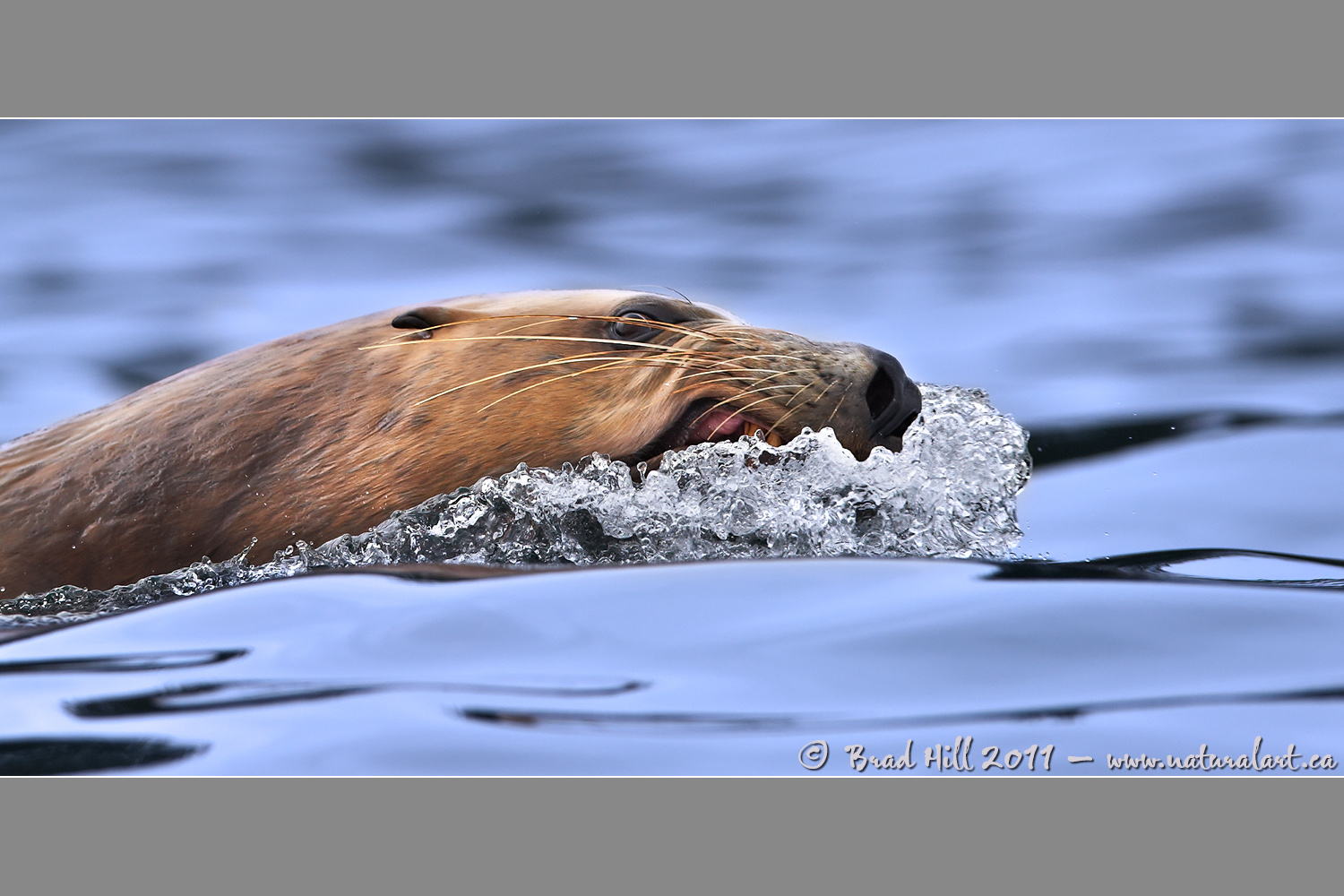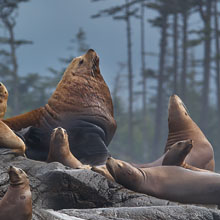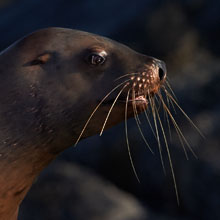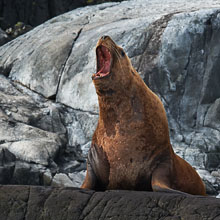Availability: Undetermined - Enquiries?
In the Field
Slicing the Surface. Northern Vancouver Island, BC, Canada. August 27, 2010.
There are times when I use my camera simply to figure out what the heck an animal is doing. Usually these "documentary-style" shots are useful in that they teach me something about the subject, but they're rarely worth showing or have any other real value. This one happens to be a case where a documentary shot actually came out kinda cool...
During a photo safari in the summer of 2010 we encountered a large colony of Steller Sea Lions hauled out on rocks. While we were still hundreds of meters away a group of about 40 of them left the rocks and approached us. When they neared our inflatable boat they began checking us out. Several times one or more of them would raise their heads high above the surface and check us out in a way that made them look like periscopes. But most of the time you'd here a splash and, unless you just happened to be looking in the right place, see just the aftermath of a very fast "slicing" of the surface - a few ripples. And, even if you were looking at just the right place and saw a full "slicing" of the surface you'd swear the sea lion just skimmed the surface from below and never broke the surface. Each "slicing" took only fractions of a second. Of course, I wondered what the heck the sea lions were doing - so I decided to try to catch a "slice" in action in a photo in an effort to see what was going on. I figured the "slices" were of such short duration (and you saw so little of the sea lion) that they must be just trying to scare us away or something.
Well...here's one of the results: it's clear the sea lions were doing more than just trying to scare us off - the were using the high-speed maneuver to check us out - this guy is clearly eyeballing us (and throwing in what appears to be a snarl, just for good measure)! Mystery solved! And only because a LOT of modern imaging technology made it possible for me to capture this image - my eyes and slow reacting hominid visual processing system simply could NOT sort out what was going on.
What factors contributed the most to helping me capture this image? Well, first off - a whole lot of luck. Any wildlife photographer who doesn't admit luck plays a role in a LOT of shots is being just a LITTLE disingenuous (to say the least). Second, a high frame rate AND a very low-cost per exposure - let it suffice to say I won't show anyone the hundreds of blurry, out-of-focus messes that I shot before I captured this image (and nor would I have forked out the bucks for simple curiosity if I had to shoot several hundred FILM images just to get this shot). And last, but arguably most important, I needed to use a lens/camera combination with a lightning fast autofocus system. I DID prefocus in ABOUT the right place and waited for sea lions to "slice the surface" in the regions I was pre-focusing on, but the lens still had to adjust the focus some for virtually all the shots. One of the reasons you fork out the big bucks for professional quality super telephoto lenses is for super-fast autofocus - you don't always need it, but there are times when it's absolutely critical in getting the image you want/need. This was one of those instances...
ADDITIONAL NOTES:
1. This image - in all resolutions - is protected by copyright. I'm fine with personal uses of it (including use as desktop backgrounds or screensavers on your own computer), but unauthorized commercial use of the image is prohibited by law. Thanks in advance for respecting my copyright!
2. Like all wildlife photographs on this website, this image was captured following the strict ethical guidelines described in The Wildlife FIRST! Principles of Photographer Conduct. I encourage all wildlife photographers to always put the welfare of their subjects above the value of their photographs.
3. This image was captured during my "Humpback, Orcas, Sea Lions & More" photo tour in August of 2010. Each year I offer trips into two different parts of the Great Bear Rainforest as well as one to photograph aquatic mammals and oceanscapes near the northern tip of Vancouver Island. And, in selected years, I also offer photo tours to locations to capture other highly sought-after subjects, such as various owl species of the boreal forest and wildlife of Canada's Arctic. Details about these trips can be found on the Photo Tours page of this website.
Behind the Camera
Slicing the Surface. Northern Vancouver Island, BC, Canada. August 27, 2010.
Digital Capture; RAW 14-bit format; ISO 250.
Nikon D3s with Nikkor 400mm f2.8G VR lens hand-held and shot from Zodiac inflatable boat. VR on and set to "Normal" mode. Circular polarizer used.
1/1600s @ f4; +0.33 stop compensation from matrix-metered exposure setting.
At the Computer
Slicing the Surface. Northern Vancouver Island, BC, Canada. August 27, 2010.
RAW Conversion to 16-bit TIFF, including first-pass/capture sharpening and slight noise using Phase One's Capture One Pro 6. Three raw conversions varying in exposure settings: one at -1.25 stops to reduce brightness of foreground and background water; one at -0.55 stops to retrieve highlight detail in "frothing water" in and around the sea lion's head; one at 0.0 for the sea lion itself.
Further digital corrections on 16-bit TIFF file using Adobe's Photoshop CS5 and Light Craft's LightZone. Photoshop adjustments included compositing and masking of three source images, light application of cooling filter to foreground and background water, and selective sharpening for web output. Final tonemapping and contrast/tone tweaking performed with LightZone using the tonemapper/re-light tool.
Conservation
Slicing the Surface. Northern Vancouver Island, BC, Canada. August 27, 2010.
Ten percent of the revenue generated by this image will be donated to Raincoast*.
Species Status in Canada**: Special Concern (November 2003) - protected in Canada since 1970.
The Steller's Sea Lion (Eumetopias jubatus) is the largest of the sea-lions, and males can weigh up to a ton (females are considerably smaller and rarely weigh over 600 lb). Males compete among themselves for females, and successful males end up breeding with several females within their harem.
From the early 1900's through to the 1970's huge numbers of Steller's Sea-Lions were culled for their fur and to remove a competitor (for humans) for salmon. During that time approximately 55,000 sea lions were killed and the breeding population of BC was lowered to about 4,000 animals. Since the Steller Sea Lion first received protection in 1970 the population in the coastal waters of BC has grown to between 18,000 to 19,700 animals (7,600 or so of these are of breeding age).
*The Raincoast Conservation Society (and Foundation) is an effective and efficient organization that has been fighting for protection of this unique habitat. If you are looking for a meaningful way to contribute to the conservation of this amazing ecosystem, Raincoast will provide maximal "bang" for your conservation dollars.
**as determined by COSEWIC: The Committee on the Status of Endangered Wildlife in Canada

























